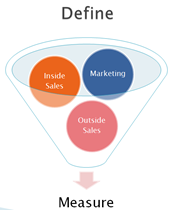Cellular manufacturing is one of the most powerful lean tools. It will allow for smaller lot production, quality improvements, and shorter lead times and simplifies the implementation of pull. Typical manufacturing systems had the same machines all grouped together and as a result batch type manufacturing was developed. As manufacturers developed cellular systems, they found quality improved and smaller lot quantities could be efficiently handled. Many of the work cells were rearranged into U-shaped or L-shaped patterns. This allowed one worker to operate several machines which improve productivity. The benefits have been very well documented and applied to many industries.
 Followers of my blog have seen how I use DMAIC principles in discussing the marketing funnel and the discussions about adding toll gates for identifying when prospects should move from one stage to the next. Inside the stages, we have different marketing programs that are taking place. But I really never talked about the personnel that were handling these programs. In most sales and marketing applications, you have marketing assigned by the duties they do and salespeople assigned to certain accounts. I think it might be interesting to consider what we have learned in U-shaped or L-shaped work cells.
Followers of my blog have seen how I use DMAIC principles in discussing the marketing funnel and the discussions about adding toll gates for identifying when prospects should move from one stage to the next. Inside the stages, we have different marketing programs that are taking place. But I really never talked about the personnel that were handling these programs. In most sales and marketing applications, you have marketing assigned by the duties they do and salespeople assigned to certain accounts. I think it might be interesting to consider what we have learned in U-shaped or L-shaped work cells.
 Instead of the typical arrangement, what would prevent an organization of assigning the personnel and cross-training them within one of the marketing stages. This way they would become experts within the stage and be able to respond to the needs of a prospect better and more efficiently. Since they are handling the tools of the stage, that particular area would have a better chance of improving the methods utilized within it.
Instead of the typical arrangement, what would prevent an organization of assigning the personnel and cross-training them within one of the marketing stages. This way they would become experts within the stage and be able to respond to the needs of a prospect better and more efficiently. Since they are handling the tools of the stage, that particular area would have a better chance of improving the methods utilized within it.
In recent times, quality has suffered in sales and marketing. Many times, the customer seems to be more of an expert than the salesperson calling on them. Other times experts have to be brought in and duplication of manpower takes place. Many companies have a sale’s closer; maybe sometimes a sales manager that would come in and have the power to close a prospect when ready. If you were doing that during each stage, the likelihood of passing on better qualified and more prospects may occur. Another consideration that someone may find fault with this type of thinking is geographic boundaries. However, I believe that excuse is seldom the case.
The key to your thinking should be in flow rather than function. Taking each individual stage and think about creating a work cell by defining the operations that take place within that stage. The number of resources within that stage will have to correlate to the number of prospects within the stage. It must be recognized that numbers don’t always work out perfectly or that certain talents may still have to be utilized in several different stages. But I believe that the quality of the interaction would increase with this type of system.
The goal in lean is continuous flow or as close to that as possible, while eliminating waste of waiting and a waste of overproduction. I believe that this type of arrangement would be an organizations first step in leveling sales volume. I’ll save that discussion for another blog post.
Do you think work cells can work in Sales and Marketing? Are they already?
Related Posts:
Bringing your Storyboard Alive!
A Little more on applying Little’s Law to Lean your Marketing!
